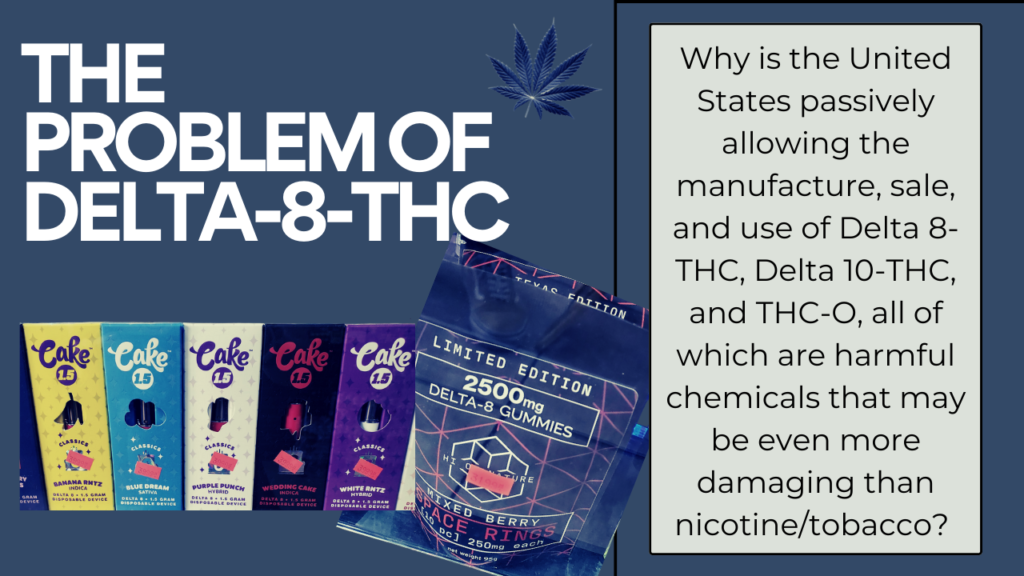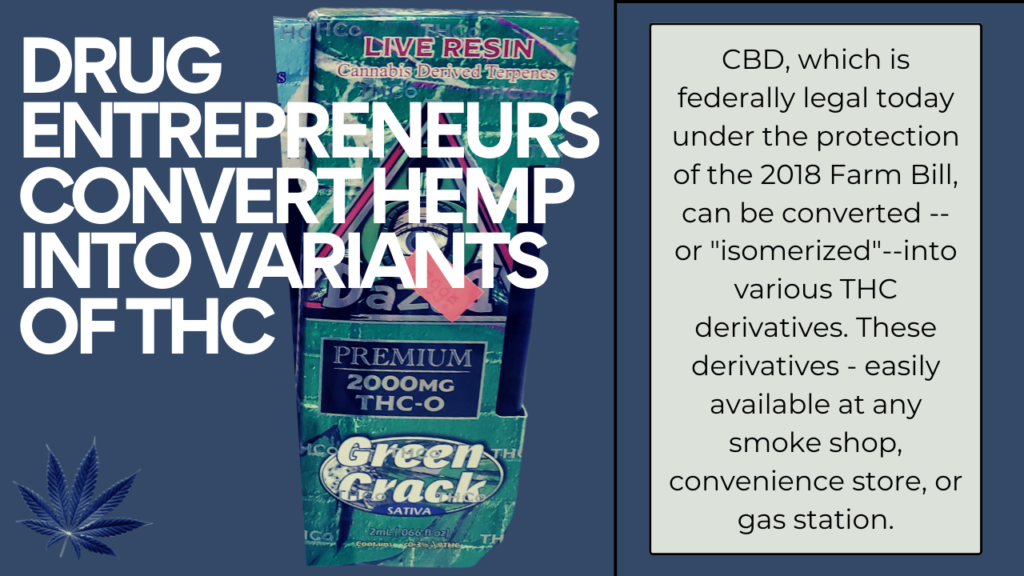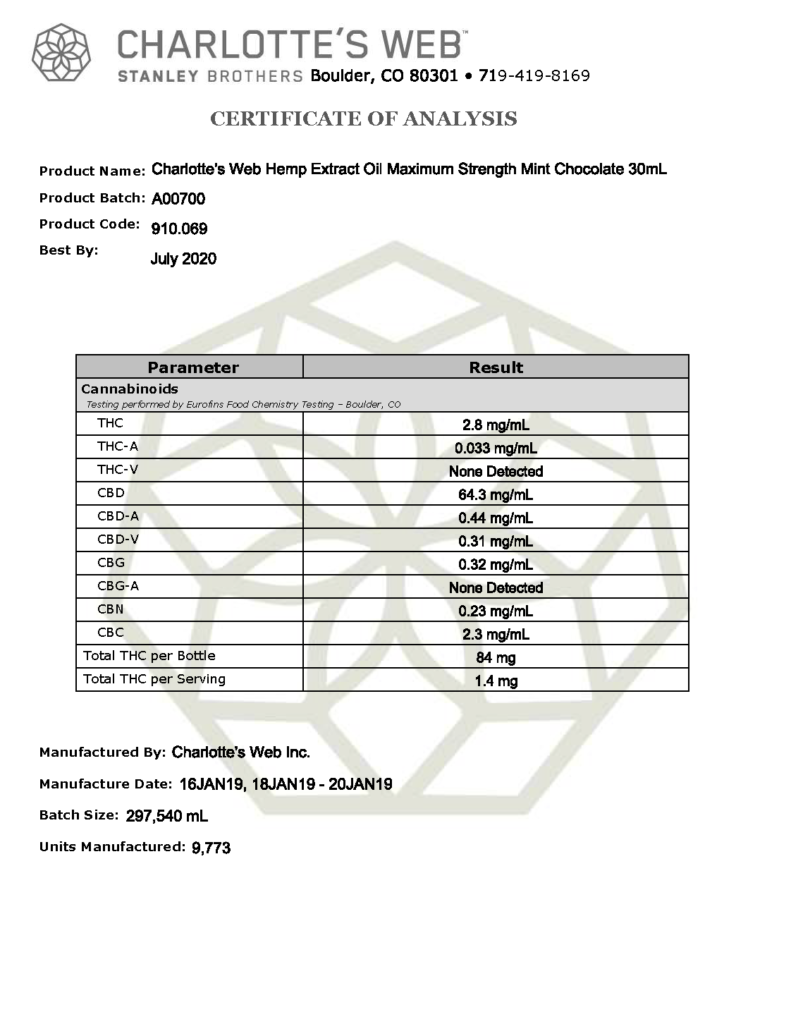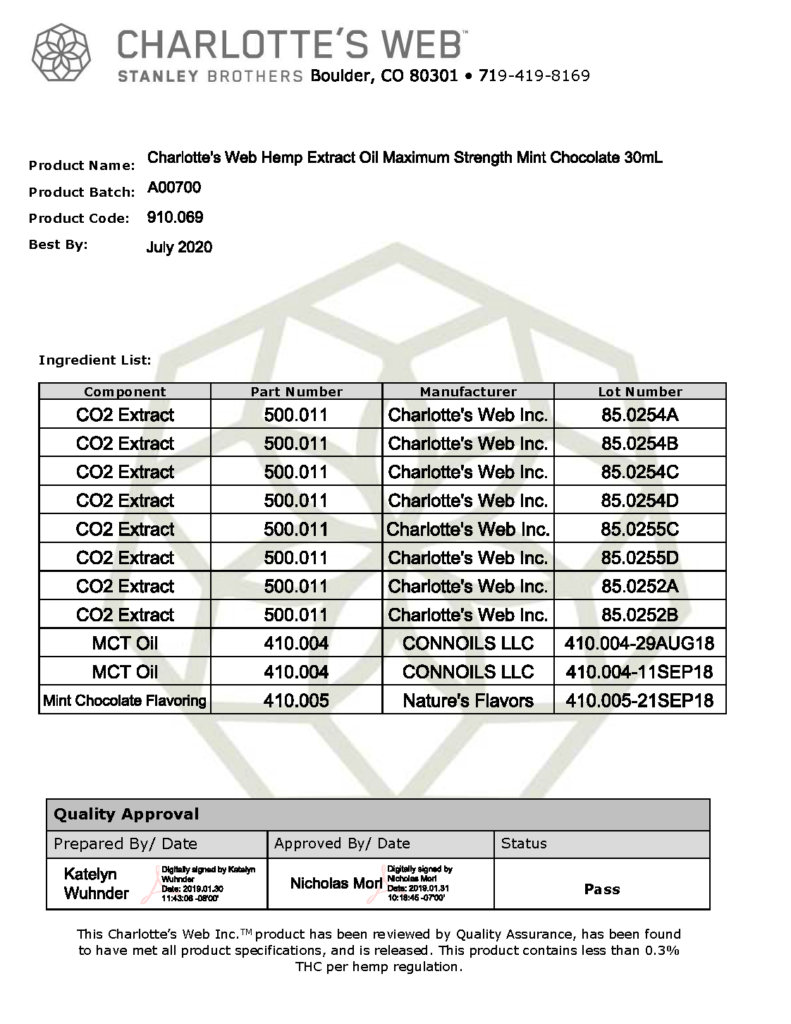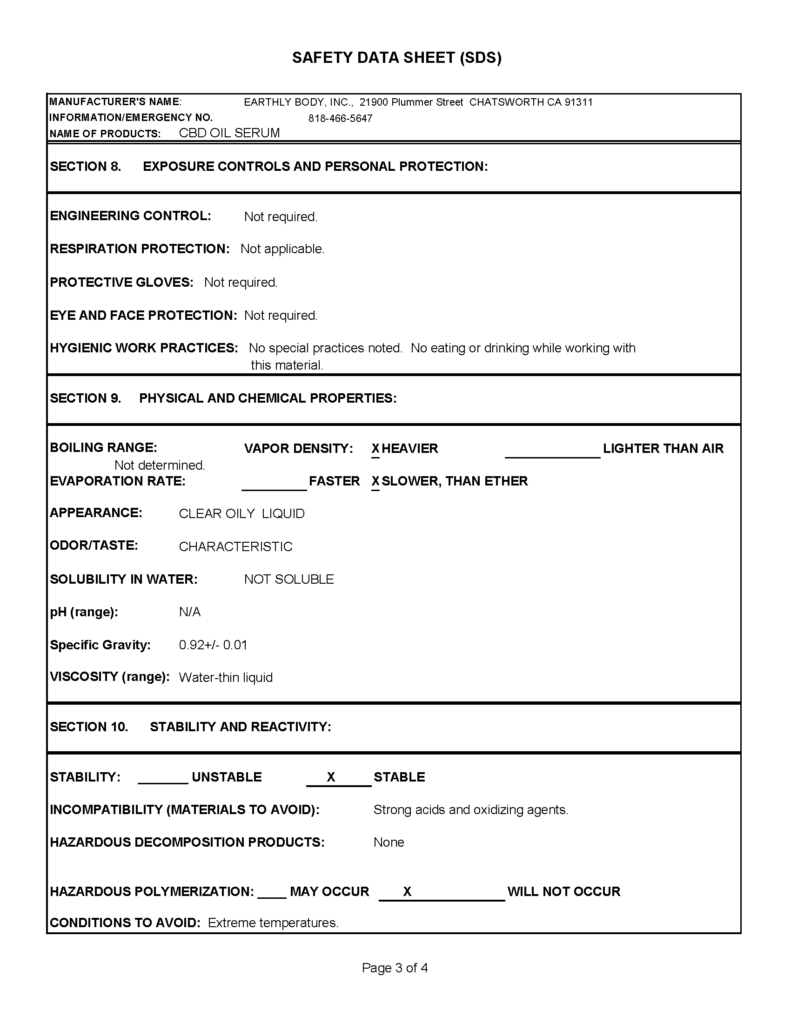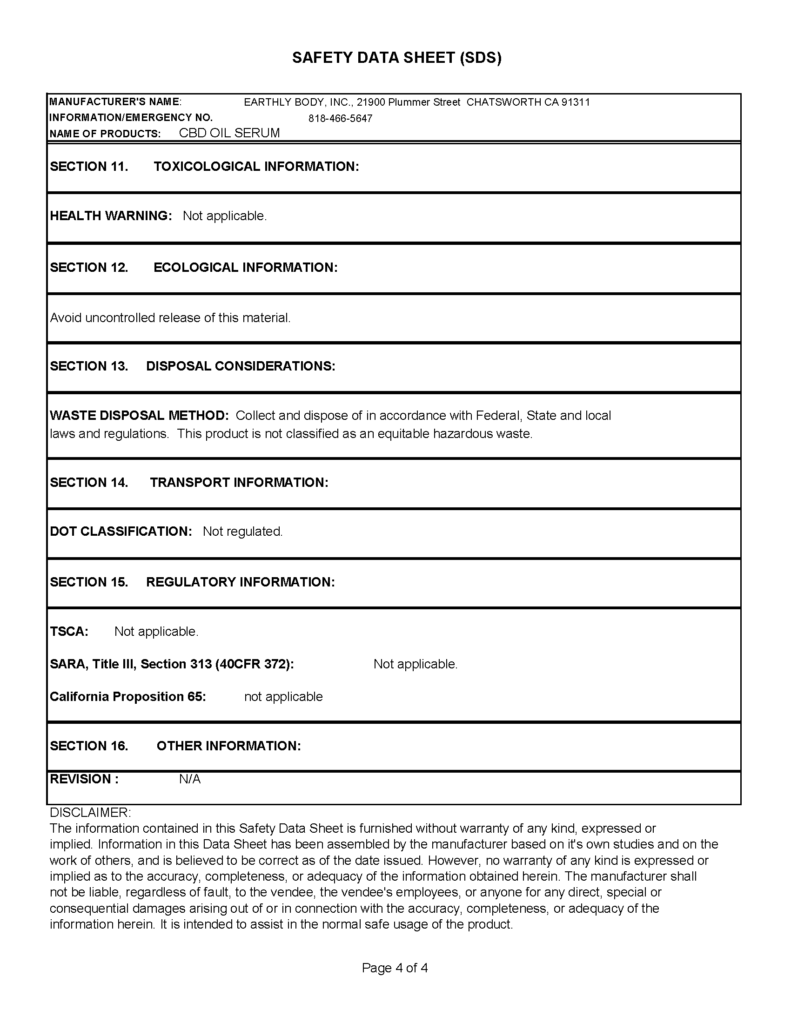THC Variants (Delta-8-THC, Delta-10-THC, THC-0)
Scroll to the bottom of the page to understand the 2018 FARM BILL MATH
- Delta-8-THC association with psychosis: A case report with literature review 2023, Feb 20
- The Dark Side of Cannabidiol: The Unanticipated Social and Clinical Implications of Synthetic Δ8-THC, 2022 Oct 19.
- Everything There is to Know About THC-H 2022, September 1
- Is THCP: Is It Really 33 Times Stronger Than THC? 2022, August 23
- Vaping Cannabinoid Acetates Leads to Ketene Formation 2022 May, 5
- 5 Things to Know about Delta-8 Tetrahydrocannabinol – Delta-8 THC 2022, May 4
- Explanation of Delta 8-THC, Delta 10-THC, and THC-O Acetate, 2022, February 10
- Drug Entrepreneurs Convert Hemp into Variants of THC 2022, February 2
- Unknown risks of psychosis and addiction with delta-8-THC: A call for research, regulation, and clinical caution 2021, December 17
- Increases in Availability of Cannabis Products Containing Delta-8 THC and Reported Cases of Adverse Events 2021, September 14
- The Problem of Delta 8-THC, 2021, November 7
- What’s in your Delta-8? (13 unknown chemicals)
5 Things to Know about Delta-8 Tetrahydrocannabinol – Delta-8 THC
U.S. Food and Drug Administration 2022, May 4
Delta-8 tetrahydrocannabinol, also known as delta-8 THC, is a psychoactive substance found in the Cannabis sativa plant, of which marijuana and hemp are two varieties. Concentrated amounts of delta-8 THC are typically manufactured from hemp-derived cannabidiol (CBD).
It is important for consumers to be aware that delta-8 THC products have not been evaluated or approved by the FDA for safe use in any context. They may be marketed in ways that put the public health at risk and should especially be kept out of reach of children and pets.
Here are 5 things you should know about delta-8 THC to keep you and those you care for safe from products that may pose serious health risks…
Increases in Availability of Cannabis Products Containing Delta-8 THC and Reported Cases of Adverse Events
CDC Health Alert Network 2021, September 14
Summary
The purpose of this Health Alert Network (HAN) Health Advisory is to alert public health departments, healthcare professionals, first responders, poison control centers, laboratories, and the public to the increased availability of cannabis products containing delta-8 tetrahydrocannabinol (THC) and the potential for adverse events due to insufficient labeling of products containing THC and cannabidiol (CBD)…
Drug Entrepreneurs Convert Hemp into Variants of THC 2022, February 10
Jesse LaBlanc, a mechanical engineer with experience in the chemical industry and a member of our Board of Directors, 2022, February 10
CBD, which is federally legal today under the protection of the 2018 Farm Bill, can be converted –or “isomerized”–into various THC derivatives. These derivatives – easily available at any smoke shop, convenience store, or gas station – are now being made 3 times stronger by the “acetylation” process. Let’s take a minute and look at why this is a “big deal” and needs to be addressed…
Explanation of Delta 8-THC, Delta 10-THC, and THC-O Acetate
Jesse LaBlanc, a mechanical engineer with experience in the chemical industry and a member of our Board of Directors, 2022, February 2
CBD is considered a hydrocarbon molecule comprised of twenty-one carbon atoms, thirty hydrogen atoms, and two oxygen atoms. It can therefore be denoted as C21H30O2. There are other molecules that have the exact same number of carbon, hydrogen, and oxygen atoms, and they are known as isomers.4
Both the Delta 8-THC and Delta 10-THC variants are isomers of CBD. Also, the naturally occurring and psychoactive Delta 9-THC in cannabis plants (hemp and marijuana) is an isomer of CBD. All of these variants thus have the same molecular formula, namely C21H30O2. However, they are different structurally.5 …
The Problem of Delta 8-THC
2021, November 7
Jesse LaBlanc, a mechanical engineer with experience in the chemical industry and a member of our Board of Directors
Currently, hemp-derived CBD is being synthesized and converted into these chemicals, which are then made into different products for retail sale.1, 2, 3 We can see many of these products being advertised for sale online, in vape & smoke shops, gas stations, and convenience stores in almost every state. These items are even being marketed to children through the use of very inviting packaging and products, such as the all popular gummy bears. Luckily, some state authorities have decided to stop the sale of these products because health officials have identified that there is a potential for serious harm when using these chemicals.
The FDA even recently issued a warning about one of these synthetically produced chemicals, namely Delta 8-THC…
2018 FARM BILL MATH – 9/22-22R1 (with REferences)
- “Hemp” is defined in the 2018 Farm Bill (Agriculture Improvement Act of 2018) as follows:
- “The term ‘hemp’ means the plant Cannabis sativa L. and any part of that plant, including the seeds thereof and all derivatives, extracts, cannabinoids, isomers, acids, salts, and salts of isomers, whether growing or not with a Delta 9 Tetrahydrocannabinol (THC) concentration of not more than 0.3 percent on a dry weight basis.”1
- So what does 0.3% THC by dry weight represent? (Note 1: dry weight means the weight of a substance without water2)
- 0.3% equals 0.003 or 3 divided by 1,000, which can be written mathematically as a ratio, specifically 3/1,000. (Note 2: In order to change a percentage to a number, the percentage is divided by 100.)
- Since the discussion is about a dry weight percent, the units have to be related to a weight measurement, either in US or metric units. For simplicity, metric units will be used in the following analysis, specifically grams and milligrams (ml) because most food items’ weights are listed in grams on their respective nutrition labels and many medications’ and supplements’ doses are expressed in the weight unit of milligrams or simply “mg”.
- 0.3% THC equates to 3 mg of THC per 1,000 mg of total product dry weight or simply 3 mg THC/1,000 mg. Because 1,000 mg equals 1 gram in the metric system, the ratio can also be written as 3 mg THC/gram.
- 3 mg THC/gram may seem like a small amount of THC and therefore insignificant, but it is NOT.
- 0.3% THC equates to 3 mg of THC per 1,000 mg of total product dry weight or simply 3 mg THC/1,000 mg. Because 1,000 mg equals 1 gram in the metric system, the ratio can also be written as 3 mg THC/gram.
(Note 3: Keep in mind that the legal edible serving size for THC in Colorado is 10 mg, and a single product cannot contain more than 100 mg of THC. This was done after recreational marijuana legalization in a set of emergency rules in August 2014 because of public health concerns.)3, 4
- What food represents one gram in weight?
- One raisin weighs between 0.5 gram and 1.5 grams, so the average weight for a raisin would be about 1 gram.5
- Scaling up a bit…per the nutritional label on a bag of Tostitos Corn Chips, one serving size is specified as 7 chips, which equals to 28 grams.6 Thus, each chip would weigh about 4 grams (28 grams divided by 7 chips). Assuming that these chips could be made from hemp seed flour, one chip could legally contain up to 12 mg of THC (4 grams X 3 mg/gram), and keep in mind that no one ever eats just one corn chip! Also consider the 28 grams, or 7 chips, serving size noted on the Tostitos bag. This serving size could contain up to 84 mg of THC (28 grams X 3 mg THC/gram)! Corn chips also contain very little moisture in the form of water; it is only about 1% to 2.5%.7
- Charlotte’s Web, a hemp-based CBD oil product, comes in a typical 30 milliliter (ml) bottle and can legally contain up to 84 mg of THC (per the product’s lab analysis).8
- 30 ml of hemp oil weighs about 93% of the weight of the same volume of water.9 (Note 4: Water weighs approximately 1,000 grams/1,000 ml.10) Hemp oil would therefore weigh about 930 grams/1,000 ml, so a 30 ml bottle of hemp oil would weigh about 27.9 grams, which means that it could contain up to 83.7 mg of THC (27.9 grams X 3 mg THC/gram). This weight calculated THC value closely approximates the 84 mg of THC noted in the attached Charlotte’s Web lab report.
- 30 ml is approximately one fluid ounce (oz).11 Therefore, 30 ml X 1oz/30ml x 12 bottles of hemp-based CBD oil = 12 oz, which is the same volume as a typical can or bottle of cola or beer. Since one 30 ml bottle of Charlotte’s Web contains 84 mg of THC, a 12 oz can or bottle of this oil could contain up to 1,008 mg of THC. What is especially concerning is the potential THC content of a 12 oz can or bottle of a hemp-based beverage; it could easily be near or even above 1,000 mg depending on the ingredients used and moisture (water) content of the beverage!
- Hemp-based products can also contain other synthetically produced chemicals that exist only in very small amounts or do not exist at all. These synthetically produced chemicals include Delta 8 THC, Delta 10 THC, Delta 8 THC-O Acetate, THC-P, and THC-H, to name just a few.12, 13, 14, 15 The quantities of these chemicals are not limited by any federal regulations, and no one knows what the true effects are when unnatural quantities of these are combined with Delta 9 THC and used either “medicinally” or recreationally.
References:
- https://www.congress.gov/bill/115th-congress/senate-bill/2667/text
- https://www.hortidaily.com/article/9367055/what-is-the-difference-between-fresh-weight-and-dry-weight/
- https://cannabis.colorado.gov/responsible-use/safety-with-edibles
- https://adai.uw.edu/wordpress/wp-content/uploads/2020/11/THCinColorado2020.pdf
- https://www.omnicalculator.com/biology/dog-raisin-toxicity
- https://www.amazon.com/Tostitos-Scoops-Tortilla-Chips-Ounce/dp/B000UENHH4
- https://www.kpmanalytics.com/news-events-stories/tortilla-and-corn-chip-moisture-and-oil
- Attached file – Charlotte’s Web Analysis
- Attached file – SDS-CBD-OIL-SERUM – refer to the specific gravity section
- https://www.inchcalculator.com/water-weight-calculator/
- https://www.convertunits.com/from/30+ml/to/oz
- https://www.diamondcbd.com/hemp-blog/delta-10-vs-delta-8
- https://www.forbes.com/sites/dariosabaghi/2022/01/18/what-is-thc-o-acetate-and-why-is-it-getting-attention/?sh=52d9eef75991
- https://secretnaturecbd.com/blogs/cbd/what-is-the-cannabinoid-thcp
- https://herb.co/learn/what-is-thch/
